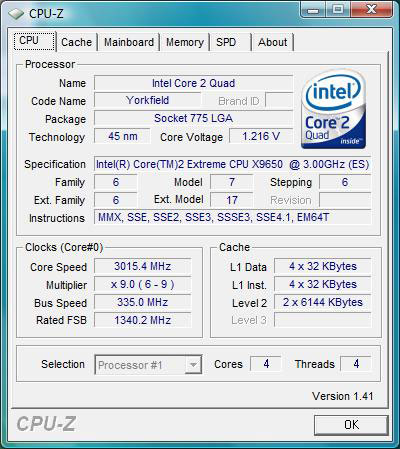Intel Core 2 Extreme QX9650 - Penryn Ticks Ahead
by Anand Lal Shimpi on October 29, 2007 12:13 AM EST- Posted in
- CPUs
What do we have here today? Yorkfield
The problem with Intel's codenames these days is that we've got processor family codenames and then actual chip codenames. Penryn refers to the entire family of 45nm Core architecture products that have been/are being announced, but the actual chips themselves all have their own codenames. For example, the 45nm Penryn based quad-core Xeon processor is codenamed Harpertown. Penryn on the desktop carries two names: Yorkfield and Wolfdale.
Yorkfield is quad-core Penryn for the desktop, Wolfdale is simply dual-core. Yorkfield isn't actually a different die, because a Yorkfield chip is just made up of two Wolfdale die on the same package (just like current quad-core Kentsfield Intel CPUs). This won't change until Nehalem.

The chip that Intel is launching today is the first Yorkfield: the Core 2 Extreme QX9650. The quad-core QX9650 runs at 3.0GHz with a 1333MHz FSB, much like its predecessor the QX6850. Like all Yorkfield CPUs, the QX9650 is made up of two independent dual-core die on a single package, each one with a shared 6MB L2 cache for a total of 12MB of on-chip L2 cache.

QX9650 (left), QX6850 (right)
The QX9650 will work in a number of presently shipping motherboards; we tested ours in an ASUS P35 board, but you'll have to check with your board vendor - or check our Penryn Compatibility article - to make sure that there's BIOS/board support for it. The chip is still physically an LGA-775 processor so it'll fit in any LGA-775 socket; it's just up to the motherboard guys to implement hardware and BIOS level support for the processor.
Pricing hasn't been announced yet but we expect the QX9650 to come in at the $999 mark, the same as previous Core 2 Extreme parts.
Test Configuration
| CPU: | Intel Core 2 Extreme QX9650 (3.00GHz/1333MHz) Intel Core 2 Extreme QX6850 (3.00GHz/1333MHz) |
| Motherboard: | Gigabyte GA-X38-DQ6 (Intel X38) |
| Chipset: | Intel X38 |
| Chipset Drivers: | Intel 8.1.1.1010 (Intel) |
| Hard Disk: | Seagate 7200.9 300GB SATA |
| Memory: | Corsair XMS2 DDR2-800 4-4-4-12 (1GB x 2) |
| Video Card: | NVIDIA GeForce 8800 GTX |
| Video Drivers: | NVIDIA ForceWare 163.75 |
| Desktop Resolution: | 1600 x 1200 |
| OS: | Windows Vista Ultimate 32-bit |










16 Comments
View All Comments
Canadian87 - Monday, October 29, 2007 - link
I'd like to point out that someone must have been tired when writing this. The graphs here on page 4 say "QX6950" VS "QX6850", simple reversal of the numbers, but I'd like to correct it for those that might be confused, took me a moment to figure out which was which myself the "QX6950" is ment to be the "QX9650", and obviously the "QX6850" is the correct naming.GL HF.
GlassHouse69 - Monday, October 29, 2007 - link
ew.intel again ftw. blech. They made a great chip. power usage is fantastic. One could get even lower total wattages (by far) if they concentrated on doing so. a quad core that can be cooled near silently. neat :)
sprockkets - Monday, October 29, 2007 - link
Just a question, what was the difference from Core to Core 2? All I could ever fine was cache size was increased.Now that I'm thinking about it, why not the name Quadro? Oh, nVidia ownz it.
defter - Monday, October 29, 2007 - link
Core Duo (Yonah) was based on Pentium M.Core2 (Conroe) is a new architecture.
sprockkets - Monday, October 29, 2007 - link
actually i found a comparison page about it, and core 2 isn't that much different from core. Yes, it updated a lot and gave improved performance. No, it is not a completely new architecture from PM, but you can say a big difference from the P4.http://www.anandtech.com/showdoc.aspx?i=2808&p...">http://www.anandtech.com/showdoc.aspx?i=2808&p...
sprockkets - Monday, October 29, 2007 - link
On page 9 I believe you are grabbing some old benchmarks, old in the sense of your previous articles. I believe I pointed this out to you as a mistake, and now it is here in the bar graph. Again, how is it that the 2.33ghz C2D outperforms the 3ghz one?